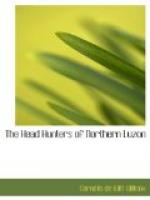Our officials regarded this great meeting as entirely satisfactory. We made ready for an early start the next morning, saying good-bye to Browne, who had accompanied us from Bayombong, and who had shown me personally many courtesies. His last act of kindness was to take back with him the various things I had got together, and later to send them on to me at Manila. Our column was to be increased by a party of Ifugaos, whom, with a head man named Comhit, Gallman wished to take through the Bontok into the Kalinga country. The fact that these men returned safely unaccompanied by Gallman or any other American is the best possible proof of the positive results already achieved by our Government in civilizing the highlanders.
CHAPTER XVII
We ride to Bontok.—Bat-nets.—Character
of the country.—
Ambawan.—Difficulties
of the trail.—Bird-scarers.—Talubin.
—Bishop Carroll
of Vigan.—We reach Bontok.—“The
Star-Spangled
Banner.”—Appearance
of the Bontok Igorot.—Incidents.
From Banawe we rode to Bontok, thirty-five miles, in one day, May 7th. This day it rained, the only rain we had during the whole trip, although the season was now on. But the disturbance in question was due to a typhoon far to the southward; and as it passed off into the China Sea, so did the day finally clear. Our first business this morning was to cross the pass on Polis Mountain, some 6,400 feet above sea-level, the highest elevation we reached. As we rode out of Banawe we could see on the wooded sky-line to our right front a cut as though of a road through the forest; it was not a road, of course, but an opening normal to the crest of the ridge. Across this a net is stretched, and the bats, flying in swarms by night to clear the top, drop into the cut on reaching it, and so are caught in the net in flying across. We saw several such bat-traps during our trip. In this way these highlanders eke out their meager supply of meat. The bat in question is not the animal we are familiar with, but the immensely larger fruit bat, the flesh of which is readily eaten. Our trail took us up, and sharply; by nine o’clock we had crowned the pass, and stopped for chow and rest. In front of us, as we looked back, plunged the deepest, sharpest valley yet seen, around the head of which we had ridden and across which we could look




